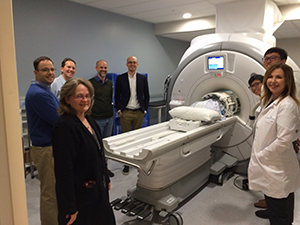Two Important Advances in HP 13C MRI from the UCSF HMTRC

There have been numerous studies to date that have shown the outstanding research and potential clinical value of hyperpolarized carbon-13 MR (HP 13C MRI). However, it requires major technological development to realize its full potential. This is one reason why the UC San Francisco Department of Radiology and Biomedical Imaging founded the Hyperpolarized MRI Technology Resource Center (HMTRC).
This Biomedical Resource Technology Center is funded by the National Institute of Biomedical Imaging and Bioengineering (NIBIB). It is led by Daniel B Vigneron, PhD, professor and operations director of the Surbeck Laboratory for Advanced Imaging at UCSF. The goal of the HMTRC is to collaboratively develop new technology to advance this field to better identify and understand human disease and ultimately to translate and disseminate these techniques for improved health care. At present, the HMTRC is based on three Technology Research & Development (TR&D) projects driven in a push-pull manner by collaborative projects. According to Dr. Vigneron, there are two recent papers that show important advances.
 The first is a clinical feasibility study that reports the results of the first-ever pilot imaging study of prostate cancer metastases to the bone and liver using HP 13C-pyruvate MRI. Before this study, this imaging modality was successfully utilized in prostate cancer only in localized disease. Six patients with metastatic castration-resistant prostate cancer were recruited. Findings show that HP 13C-pyruvate MRI has ability to detect metabolism and response in metastatic prostate cancer, an important unmet need. The study supports future clinical studies of this imaging modality in the setting of advanced prostate cancer. The full research was recently published in Nature - Prostate Cancer and Prostatic Diseases.
The first is a clinical feasibility study that reports the results of the first-ever pilot imaging study of prostate cancer metastases to the bone and liver using HP 13C-pyruvate MRI. Before this study, this imaging modality was successfully utilized in prostate cancer only in localized disease. Six patients with metastatic castration-resistant prostate cancer were recruited. Findings show that HP 13C-pyruvate MRI has ability to detect metabolism and response in metastatic prostate cancer, an important unmet need. The study supports future clinical studies of this imaging modality in the setting of advanced prostate cancer. The full research was recently published in Nature - Prostate Cancer and Prostatic Diseases.
The second paper shows results of the first in-human study of C2-pyruvate following FDA-IND & IRB approval that gives additional information over what has been used in all other human studies. This study demonstrated a significant first step for HP metabolic imaging to diagnose neurological disorders potentially at an early stage and monitor treatment response. It demonstrated the feasibility and initial normative values for HP [2-13C] pyruvate NMR and thus serves as the groundwork for designing new studies of neurological disorders. Findings were published in the Journal of Magnetic Resonance Imaging (PubMed).
Overall, hyperpolarized MRI is an emerging modality that can be used to study biochemical reactions, including metabolic conversion, as well as pH, redox potential, perfusion, transport, and more. There are promising clinical applications for cancer imaging, as well as potential for novel experiments in pre-clinical models and cells.
Learn more about the Hyperpolarized MRI Technology Resource Center (HMTRC).
